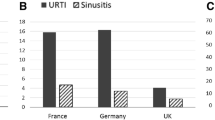Abstract
Background and objective
β-Lactam antibiotics are the recommended first-line treatment for acute bacterial sinusitis. Fluoroquinolones are recommended in patients with hypersensitivity reactions to penicillins, and macrolide antibiotics are no longer recommended. The objectives of this study were to understand whether outpatient antibiotic prescribing practices adhere to treatment guidelines and to describe rates of fluoroquinolone and macrolide antibiotic prescribing for the treatment of sinusitis.
Methods
This was a retrospective cross-sectional study using US National Ambulatory Medical Care Survey (NAMCS) data. The prevalence of antibiotic prescribing for sinusitis was estimated, and the antibiotic prescribing pattern was measured. Additionally, significant factors associated with various antibiotic prescribing during the visits related to sinusitis were identified.
Results
Among physician visits related to sinusitis from 2013 to 2016 (n = 2739), 66.4% involved antibiotic prescribing. Visits with antibiotic prescribing showed greater proportions of patients aged < 18 years (21.7 vs 11.1%, p < 0.001), patients reporting fever (79.8 vs 50.7%, p < 0.001), and patients seeing family physicians or internal medicine specialists (68.4 vs 44.8%, p < 0.001) than those without antibiotic prescribing. Penicillins, macrolides, cephalosporins, and fluoroquinolones were prescribed in 42.2%, 30.6%, 15.2%, and 9.5% of the visits involving antibiotic prescribing for sinusitis, respectively. The odds of fluoroquinolone/macrolide prescribing were reduced by 73% if patients visited pediatricians and by 59% with otolaryngologists.
Conclusions
Macrolides were the most common inappropriate antibiotic class prescribed for sinusitis. This study identifies a need for more focused attention to improve prescribing for sinusitis and adherence to the treatment guidelines.

Similar content being viewed by others
References
Centers for Disease Control and Prevention. Antibiotic resistance threats in the United States. 2013. http://www.cdc.gov/drugresistance/threat-report-2013/. Accessed 19 Nov 2017.
Centers for Disease Control and Prevention. Core elements of hospital antibiotic stewardship programs. https://www.cdc.gov/antibiotic-use/healthcare/ implementation/core-elements.html. Accessed 19 Nov 2017.
The Joint Commission. Antimicrobial stewardship. https://www.jointcommission.org/antimicrobial_stewardship_faqs/. Accessed 19 Nov 2017.
Centers for Disease Control and Prevention. Antibiotic use in the United States, 2017: Progress and opportunities. US Department of Health and Human Services, CDC. 2017. https://www.cdc.gov/antibiotic-use/stewardship-report/pdf/stewardship-report.pdf. Accessed 19 Nov 2017.
Sanchez GV, Fleming-Dutra KE, Roberts RM, et al. Core elements of outpatient antibiotic stewardship. MMWR Recomm Rep. 2016;65(6):1–12.
Fleming-Dutra KE, Hersh AL, Shapiro DJ, et al. Prevalence of inappropriate antibiotic prescriptions among US ambulatory care visits, 2010–2011. JAMA. 2016;315(17):1864–73.
Sharma P, Finley R, Weese S, et al. Antibiotic prescriptions for outpatient acute rhinosinusitis in Canada, 2007–2013. PLoS One. 2017;12(7):e0181957. https://doi.org/10.1371/journal.pone.0181957.
Wald E, Applegate K, Bordley C, et al. Clinical practice guideline for the diagnosis and management of acute bacterial sinusitis in children aged 1 to 18 years. Pediatrics. 2013;132(1):e262–80.
Chow AW, Benninger MS, Brook I, et al. IDSA clinical practice guideline for acute bacterial rhinosinusitis in children and adults. Clin Infect Dis. 2012;54(8):e72–112.
Rosenfeld R, Piccirillo J, Chandrasekhar S, et al. Clinical practice guideline (update): adult sinusitis. Otolaryngol Head Neck Surg. 2015;152(2 Suppl):S1–39.
Harrison CJ, Woods C, Stout G, et al. Susceptibilities of Haemophilus influenzae, Streptococcus pneumoniae, including serotype 19A, and Moraxella catarrhalis paediatric isolates from 2005 to 2007 to commonly used antibiotics. J Antimicrob Chemother. 2009;63(3):511–9.
Goodman RA, Posner SF, Huang ES, et al. Defining and measuring chronic conditions: imperatives for research, policy, program, and practice. Prev Chronic Dis. 2013;10:E66. https://doi.org/10.5888/pcd10.120239.
Meltzer EO, Hamilos DL. Rhinosinusitis diagnosis and management for the clinician: a synopsis of recent consensus guidelines. Mayo Clin Proc. 2011;86(5):427–43.
Zhou L, Dhopeshwarkar N, Blumenthal KG, et al. Drug allergies documented in electronic health records of a large healthcare system. Allergy. 2016;71(9):1305–13.
Lee CE, Zembower TR, Fotis MA, et al. The incidence of antimicrobial allergies in hospitalized patients: implications regarding prescribing patterns and emerging bacterial resistance. Arch Intern Med. 2000;160(18):2819–22.
Macy E, Ngor EW. Safely diagnosing clinically significant penicillin allergy using only penicilloyl-poly-lysine, penicillin, and oral amoxicillin. J Allergy Clin Immunol Pract. 2013;1(3):258–63.
Sagar PS, Katelaris CH. Utility of penicillin allergy testing in patients presenting with a history of penicillin allergy. Asia Pac Allergy. 2013;3(2):115–9.
Beckett CL, Harbarth S, Huttner B. Special considerations of antibiotic prescription in the geriatric population. Clin Microbiol Infect. 2015;21(1):3–9.
U.S. Food & Drug Administration. FDA drug safety communication: FDA updates warnings for oral and injectable fluoroquinolone antibiotics due to disabling side effects. https://www.fda.gov/Drugs/DrugSafety/ucm511530.htm. Accessed 19 Nov 2017.
U.S. Food & Drug Administration. FDA drug safety communication: FDA reinforces safety information about serious low blood sugar levels and mental health side effects with fluoroquinolone antibiotics; requires label changes. https://www.fda.gov/Drugs/DrugSafety/ucm611032.htm/ Accessed 30 July 2018.
Author information
Authors and Affiliations
Corresponding author
Ethics declarations
Funding
No source of funding was used for this study.
Conflicts of Interest
The authors have no conflicts of interest that are directly relevant to the content of this article.
Electronic supplementary material
Below is the link to the electronic supplementary material.
Rights and permissions
About this article
Cite this article
Giles, A.B., Wu, J. & Shealy, K.M. The use of fluoroquinolones and macrolides for sinusitis: a retrospective cross-sectional study. Drugs Ther Perspect 35, 518–526 (2019). https://doi.org/10.1007/s40267-019-00652-6
Published:
Issue Date:
DOI: https://doi.org/10.1007/s40267-019-00652-6




